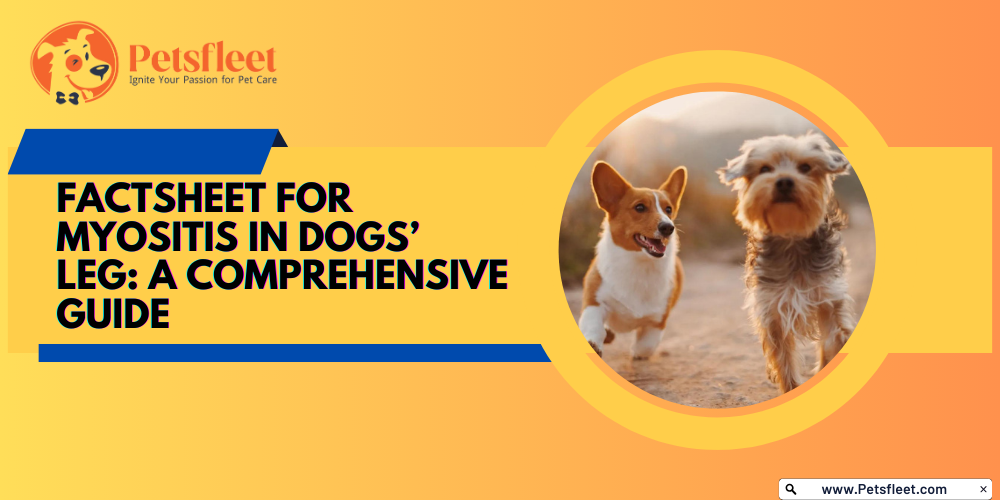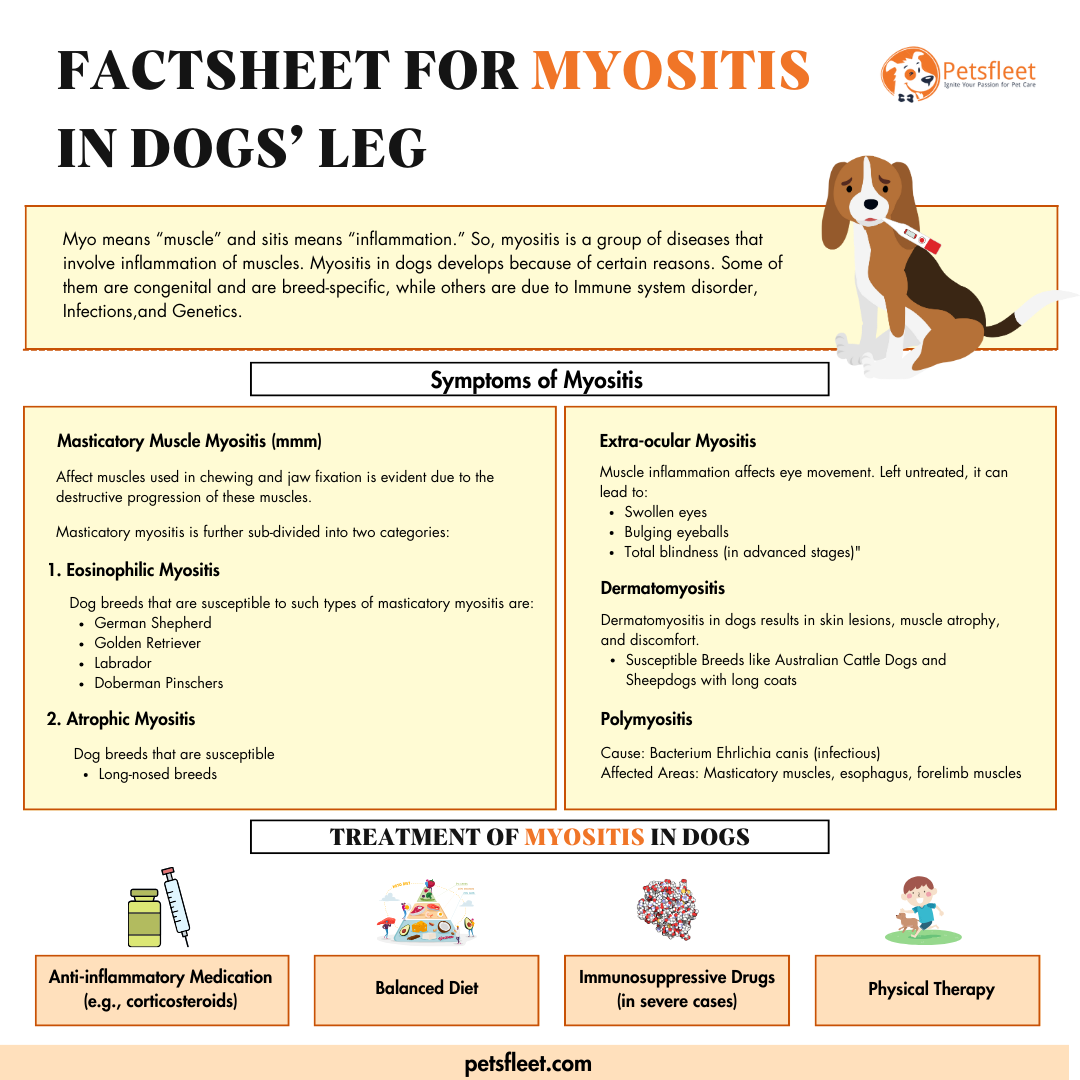Factsheet for Myositis in dogs’ leg: A Comprehensive Guide

Factsheet for Myositis in dogs’ leg, With this comprehensive guide, we will dive deeper into the world of myositis in dogs, shedding light on its causes, most common symptoms, and ways to prevent it. It’s important for dog owners to be well-informed about health issues that can affect their pets, and myositis is one such condition that needs to be addressed. At first, we try to know what myositis means in dogs exactly?
What is Myositis?
Myo means “muscle” and sitis means “inflammation.” So, myositis is a group of diseases that involve inflammation of muscles. The muscle could be of a particular area of the dog’s body, such as masticatory myositis (inflammation of cheek muscle), or there might be generalized muscle weakness and atrophy involving a group of muscles of the dog’s legs thus rendering stiff walking.
Causes of myositis in dogs vary from hereditary nature to immune-mediated responses. For instance, masticatory myositis involves an immune-mediated attack on the masticator muscle, thus conferring inflammation and other related symptoms.
What are the causes of myositis in dogs?
Myositis in dogs develops because of certain reasons. Some of them are congenital and are breed-specific, while others are linked with external factors. Some common causes include:
Immune system disorder: One of the leading causes of myositis in dogs is the over-activation of the immune system. In this case, your dog’s immune system mistakenly starts attacking muscle tissues and ends up with muscle inflammation and deterioration.
Read More: https://petsfleet.com/how-to-safely-maintain-your-dogs-ear-hygiene/
Infections: Certain viral and bacterial infections result in imposing myositis in dogs. These infectious entities either directly hit the muscle tissue or trigger an immune-mediated response to destroy them. For example, streptococcal infections in dogs.
Genetics: Some dog breeds are prone to develop myositis. Certain breeds like Boxer and Shetland Sheepdog are easy prey to myositis. Genetic testing can help to avoid its occurrence.

Environmental factors: Sometimes, dogs develop myositis by getting exposure to certain environmental allergens and toxins. That’s why always try to avoid your dog from an environment containing potential hazards to prevent myositis.
What are the symptoms of Myositis in dogs?
Symptoms of myositis greatly depend on the type of muscle affected. So, we have discussed some major types of myositis along with their symptoms:
1-Masticatory Muscle Myositis (mmm)
Masticatory muscle myositis (mmm) is known to affect muscles used in chewing that are present on the sides of the face and the top of the head. Jaw fixation is evident due to the destructive progression of these muscles. Moreover, such type of muscle inflammation is believed to be immune-mediated. Masticatory myositis is further sub-divided into two categories:
- a) Eosinophilic myositis
Dog breeds that are susceptible to such types of masticatory myositis are:
- German Shepherd
- Golden Retriever
- Labrador
- Doberman Pinschers
- b) Atrophic myositis
The most prevalent dog breeds that suffer atrophic myositis are:
- Long-nosed breeds
Symptoms:
- Swelling of jaw
- Jaw moving difficulty
- Loss of muscles
- Inability to open mouth
- Pain in jaw
- Muscle atrophy
- Eating and drinking problems
- Jaw fixation
- Sunken eyes
- Anorexia
- Weight loss
- Blindness
2-Extra-ocular myositis
It involves the inflammation and disparity of muscles that are linked with eyeball movements. In this scenario, your dog may get impaired vision and consequently will face complete blindness if it remains unchecked for a long duration. Some common symptoms include:
Symptoms:
- Swelling around eyes
- Eyeball protrusion
- Impaired vision
- Complete blindness (in later stages)
3-Dermatomyositis
Dermatomyositis in dogs is considered to bring about skin lesions along with muscle atrophy that greatly affects the life quality of your dog. Dog breeds, including Australian Cattle Dogs, Sheepdogs, and other related breeds with long coats, are more prone to dermatomyositis.
Symptoms:
- Skin lesions
- Muscular pain
- Muscle atrophy
- Abnormal gait
- Lesions (face, feet, ears, and tail)
4-Polymyositis
Polymyositis in dogs is described as the general myositis that is mainly caused by a bacterium named Ehrlichia canis, an infectious entity. The most predilecting site for the attack of this organism includes masticatory muscles, esophagus, and forelimb muscles.
Symptoms:
- Muscle pain
- Stiff walking
- Muscle swelling
- Difficulty swallowing
- Limb muscles weakness
- Breathing problems
- Regurgitation
How to diagnose myosis in dogs?
The exact diagnosis of myositis in dogs can be made by your vet by undergoing the following tests:
Physical examination: The veterinarian will perform the examination by looking for muscle pain, weakness, and inflammation.
Blood tests: These include checking for the elevated level of an enzyme named creatine kinase (CK), which is a muscle enzyme.
Muscle biopsy: It determines the extent of muscle damage to better understand and rule out the other causes of muscle inflammation.
What is the treatment and prevention of myositis in dogs?
There is a multifaceted approach to treating and preventing myositis in dogs, which is characterized by muscle inflammation. An anti-inflammatory medication, such as corticosteroids, is usually prescribed to reduce inflammation and pain. It may be necessary to take immunosuppressive drugs in severe cases. Muscle recovery can also be assisted by physical therapy and a healthy diet rich in protein.
The best way to prevent this disease is to avoid known triggers, such as vaccinations, and ensure your dog is healthy by exercising regularly and eating right. By having regular check-ups with a veterinarian, you can catch and address early signs of myositis.

Conclusion:
A dog’s myositis is a complex condition requiring attention and care. You can ensure the health and well-being of your beloved pet by understanding its causes, recognizing symptoms early, and taking appropriate treatment and prevention measures.
FAQs
Which dog breeds are more prone to myositis?
Certain dog breeds are prone to myositis, which include Shetland Sheepdog and Boxer, because of their genetic predisposition. However, any dog can develop myositis.
Can myositis in dogs be curable completely?
It is hard to say that myositis is completely curable, but you can favor your dog with managed treatment to alleviate its symptoms and enhance its quality of life.
Is myositis contagious to other dogs?
No, myositis in dogs in not contagious, which means it can’t be transmitted to other dogs because it is caused by non-transmitted viruses and bacteria.
What is the prognosis of a dog with myositis?
The prognosis of myositis in dogs depends entirely on the extent of disease severity, timely diagnosis, and prompt treatments. Your dog can make it to fulfill his life span if treated with care.
Are there any restrictions related to diet for a dog with myositis?
A veterinarian might recommend some dietary changes to ensure the muscle health of your dog. Additionally, these recommendations vary depending on your dog’s condition.






